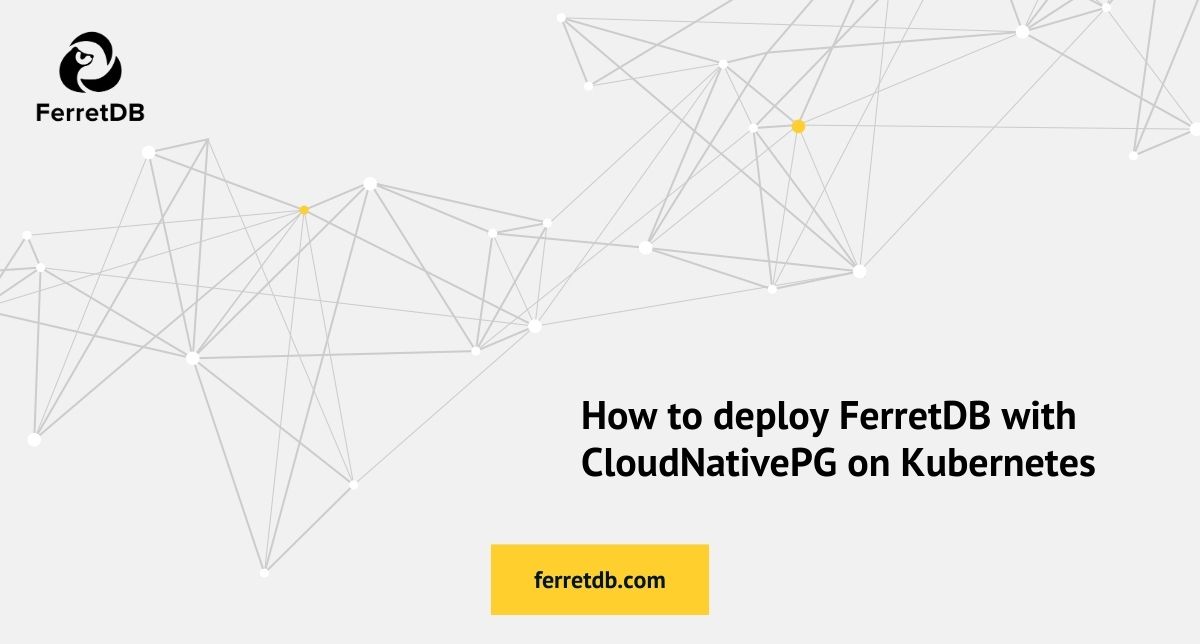How to deploy FerretDB with CloudNativePG on Kubernetes

Running FerretDB on Kubernetes typically requires managing a PostgreSQL backend. With CloudNativePG, a Kubernetes-native operator for PostgreSQL, you can automate provisioning, scaling, and failover while ensuring a production-ready infrastructure.
We previously covered how to run FerretDB on Kubernetes using CloudNativePG (CNPG) as the PostgreSQL operator. While that guide remains relevant for FerretDB v1.x, we've since released FerretDB v2.0, which brings significant changes: improved performance, better MongoDB compatibility, and new features. One key change – FerretDB v2.x now requires a PostgreSQL backend with the DocumentDB extension.
This blog post will walk you through the steps to deploy FerretDB and PostgreSQL with DocumentDB extension using CloudNativePG on Kubernetes.
Prerequisites
- A Kubernetes cluster (e.g., kind, minikube, or a managed service like GKE, EKS, or AKS).
kubectlinstalled and configured to access your cluster.helminstalled for managing Kubernetes applications.mongoshinstalled for connecting to FerretDB.
A basic architecture of the setup looks like this:
Install CNPG with Helm
Install the CNPG operator using Helm. This operator will manage the PostgreSQL cluster.
helm repo add cnpg https://cloudnative-pg.github.io/charts
helm upgrade --install cnpg \
--namespace cnpg \
--create-namespace \
cnpg/cloudnative-pg
Create the PostgreSQL cluster
We'll now define a PostgreSQL cluster using CNPG. This cluster will run 3 Postgres instances using the PostgreSQL with DocumentDB extension image.
Save this as pg-cluster.yaml:
apiVersion: postgresql.cnpg.io/v1
kind: Cluster
metadata:
name: postgres-cluster
namespace: cnpg
spec:
instances: 3
imageName: 'ghcr.io/ferretdb/postgres-documentdb:17-0.102.0-ferretdb-2.1.0'
postgresUID: 999
postgresGID: 999
enableSuperuserAccess: true
storage:
size: 1Gi
postgresql:
shared_preload_libraries:
- pg_cron
- pg_documentdb_core
- pg_documentdb
parameters:
cron.database_name: 'postgres'
bootstrap:
initdb:
postInitSQL:
- 'CREATE EXTENSION IF NOT EXISTS documentdb CASCADE;'
We explicitly enable enableSuperuserAccess so that we can connect with the default postgres user.
CloudNativePG runs PostgreSQL with UID 26 by default, but the DocumentDB image requires UID and GID 999. Be sure to set both explicitly to avoid permission errors.
Since CloudNativePG doesn't execute entrypoint scripts from the image, we need to manually create the extension during initialization.
We need to explicitly list pg_cron, pg_documentdb_core, and documentdb in shared_preload_libraries and use postInitSQL to create the extension.
The cron.database_name parameter is set to postgres to ensure that the cron jobs run in the correct database.
Apply it:
kubectl apply -f pg-cluster.yaml -n cnpg
CNPG will handle cluster creation, persistent storage, and generate a password for the postgres superuser in Secret.
You can check the status of the cluster with:
kubectl get cluster -n cnpg
You should see the cluster in Running state.
NAME AGE INSTANCES READY STATUS PRIMARY
postgres-cluster 176m 3 3 Cluster in healthy state postgres-cluster-1
To get the generated password for the postgres user:
kubectl get secret -n cnpg postgres-cluster-superuser -o jsonpath='{.data.password}' | base64 -d && echo
Deploy FerretDB
With the PostgreSQL backend ready, let's deploy FerretDB.
FerretDB expects you to specify the connection string to the PostgreSQL backend via the FERRETDB_POSTGRESQL_URL environment variable.
Save this as ferretdb.yaml:
apiVersion: apps/v1
kind: Deployment
metadata:
name: ferretdb
namespace: cnpg
spec:
replicas: 1
selector:
matchLabels:
app: ferretdb
template:
metadata:
labels:
app: ferretdb
spec:
containers:
- name: ferretdb
image: ghcr.io/ferretdb/ferretdb:2.1.0
ports:
- containerPort: 27017
env:
- name: FERRETDB_POSTGRESQL_URL
value: 'postgresql://postgres:<password>@postgres-cluster-rw.cnpg.svc.cluster.local:5432/postgres'
---
apiVersion: v1
kind: Service
metadata:
name: ferretdb-service
namespace: cnpg
spec:
selector:
app: ferretdb
ports:
- protocol: TCP
port: 27017
targetPort: 27017
type: NodePort
The connection string uses the postgres superuser created by CNPG, the service endpoint exposed by the PostgreSQL cluster (postgres-cluster-rw), and the default postgres database.
Be sure to replace <password> with the actual password you retrieved earlier.
For production environments, instead of hardcoding the password, consider using secrets to manage sensitive information.
We are also creating a service named ferretdb-service that exposes the FerretDB deployment on port 27017.
Then apply it:
kubectl apply -f ferretdb.yaml -n cnpg
Check the status of the FerretDB pod to ensure that it is running:
kubectl get pods -n cnpg
Connect to FerretDB
Expose FerretDB locally by port-forwarding its service:
kubectl port-forward svc/ferretdb-service -n cnpg 27017:27017
Then in another terminal, connect to FerretDB using mongosh:
mongosh "mongodb://postgres:<password>@localhost:27017/"
You're now connected to FerretDB via mongosh.
Test CRUD operations
Try a quick test to ensure everything is working correctly.
db.test.insertOne({ hello: 'world' })
db.test.find()
This verifies that FerretDB is up and the entire setup is functioning as expected.
Conclusion
You now have FerretDB v2 running on Kubernetes, backed by a production-grade PostgreSQL cluster managed by CloudNativePG. This setup offers MongoDB compatibility with the reliability and ecosystem of PostgreSQL. For production deployments, consider enabling backups, monitoring, authentication, and scaling strategies.
Have any questions? Reach out to us on our community channels.
